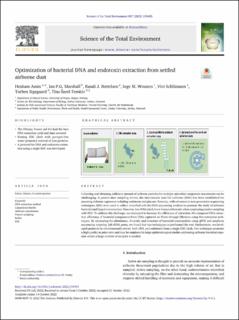| dc.contributor.author | Abouelhana, Hesham Amin Mohamed | |
| dc.contributor.author | Marshall, Ian P.G. | |
| dc.contributor.author | Bertelsen, Randi Jacobsen | |
| dc.contributor.author | Wouters, Inge M. | |
| dc.contributor.author | Schlünssen, Vivi | |
| dc.contributor.author | Sigsgaard, Torben | |
| dc.contributor.author | Šantl-Temkiv, Tina | |
| dc.date.accessioned | 2023-07-07T06:35:23Z | |
| dc.date.available | 2023-07-07T06:35:23Z | |
| dc.date.created | 2023-03-06T13:01:21Z | |
| dc.date.issued | 2023 | |
| dc.identifier.issn | 0048-9697 | |
| dc.identifier.uri | https://hdl.handle.net/11250/3077009 | |
| dc.description.abstract | Collecting and obtaining sufficient amount of airborne particles for multiple microbial component assessments can be challenging. A passive dust sampling device, the electrostatic dust fall collector (EDC) has been established for assessing airborne exposures including endotoxin and glucans. Recently, with advances in next-generation sequencing techniques, EDCs were used to collect microbial cells for DNA sequencing analysis to promote the study of airborne bacterial and fungal communities. However, low DNA yields have been problematic when employing passive sampling with EDC. To address this challenge, we attempted to increase the efficiency of extraction. We compared DNA extraction efficiency of bacterial components from EDCs captured on filters through filtration using five extraction techniques. By measuring the abundance, diversity and structure of bacterial communities using qPCR and amplicon sequencing targeting 16S rRNA genes, we found that two techniques outperformed the rest. Furthermore, we developed protocols to simultaneously extract both DNA and endotoxin from a single EDC cloth. Our technique promotes a high quality to price ratio and may be employed in large epidemiological studies addressing airborne bacterial exposure where a large number of samples is needed. | en_US |
| dc.language.iso | eng | en_US |
| dc.publisher | Elsevier | en_US |
| dc.rights | Navngivelse 4.0 Internasjonal | * |
| dc.rights.uri | http://creativecommons.org/licenses/by/4.0/deed.no | * |
| dc.title | Optimization of bacterial DNA and endotoxin extraction from settled airborne dust | en_US |
| dc.type | Journal article | en_US |
| dc.type | Peer reviewed | en_US |
| dc.description.version | publishedVersion | en_US |
| dc.rights.holder | Copyright 2022 the authors | en_US |
| dc.source.articlenumber | 159455 | en_US |
| cristin.ispublished | true | |
| cristin.fulltext | original | |
| cristin.qualitycode | 2 | |
| dc.identifier.doi | 10.1016/j.scitotenv.2022.159455 | |
| dc.identifier.cristin | 2131566 | |
| dc.source.journal | Science of the Total Environment | en_US |
| dc.identifier.citation | Science of the Total Environment. 2023, 857 (part 2), 159455. | en_US |
| dc.source.volume | 857 | en_US |
| dc.source.issue | part 2 | en_US |

